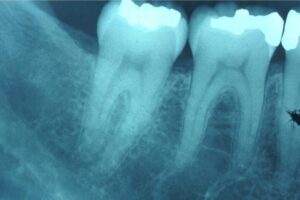Ruling out local pathology is step 1 of Dr. Glenn Clark’s 5-step process for diagnosing Chronic Trigeminal Neuralgia. Dr. Clark is the Director of the Online Master’s Degree in Orofacial Pain and Oral Medicine at the Herman Ostrow School of Dentistry of USC.
Rule out Local Pathology & Get Adequate Imaging

A standard but thorough clinical examination and high quality radiographs/MRIs are needed to rule out local pathology. Whenever you suspect AO or PTP, you must rule out local dental and periodontal pathology. Specifically the dentist seeing a patient with suspected chronic trigeminal neuralgia would begin by first ruling in or out infection and/or inflammation as a source of the pain using radiographs and probing.
If the teeth and surrounding oral tissues have a healthy appearance and probing of the gingival tissues reveals no obvious pathology, the next consideration is that there is pathology under the site of pain. This can usually be evaluated with periapical dental films and a panoramic film of the jaw.
Next the dentist must consider further afield disorders (e.g. sinus infection, myofascial pain and temporomandibular joint pain) and any local maxillofacial pathology (e.g. neoplastic disease).
Like what you’re learning? Take it a step further and test your clinical diagnosis skills with USC’s Virtual Patient Simulation. Review real-life patient histories, symptoms, and imaging, conduct a medical interview and clinical exam, make a diagnosis, and create a treatment plan for virtual patients experiencing Orofacial Pain conditions.

Common Diseases to Rule Out
Below is a list of the most common diseases you have to rule out. Depending on the situation, sometimes irreversible diagnostic treatments (e.g. root canal or extraction) are performed to see if they will have any beneficial effect. If these treatments fail to help, before performing a second diagnostic treatment on a second tooth or oral tissue site, the possibility that the patient has a neuropathic pain must be considered.
- Dentinal Pain
- Infectious Pulpitis w/o apical change (yet)
- Chronic Degenerative Pulpalgia/itis
- Cracked Tooth Pain
- Referred Pain from Adjacent Tissues
- Midface Migraine Pain
- Acute Trigeminal Neuritis (e.g. sinusitis)
- Trigeminal Neuralgia
Local & Regional Disease Testing Techniques
There are many techniques that can be used to rule out local and regional disease.
- Pulp testing (EPT, Ice, Heat).
- Illuminate and load tooth for cracks.
- Muscle and TM Joint palpation.
- Intra-Extraoral Tissue and Gland exam
- Cranial Nerve Examination.
- Dental and Panoramic films.
Continue to Step 2: Conduct Endo Ice Cold Testing to Prove Irreversible Pulpitis
